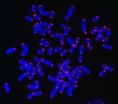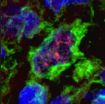(Press-News.org) KANSAS CITY, MO—Few molecules are more interesting than DNA—except of course RNA. After two decades of research, that "other macromolecule" is no longer considered a mere messenger between glamorous DNA and protein-synthesizing machines. We now know that RNA has been leading a secret life, regulating gene expression and partnering with proteins to form catalytic ribonucleoprotein (RNP) complexes.
One of those RNPs is telomerase, an enzyme that maintains chromosome integrity. In the March 25, 2012, advance online edition of Nature, researchers at the Stowers Institute for Medical Research report how the RNA TER1, a component of telomerase, is sculpted to favor interaction with its protein partner. Two ring-like proteins sequentially slip onto unprocessed TER1 RNA and hold it while it is clipped to the optimum size, folded, and capped.
That processing is essential: without it TER1 could not engage its protein partner to form the active telomerase RNP. The finding not only deepens our understanding of RNA biochemistry but also suggests novel pharmaceutical approaches to cancer and diseases of aging.
"Cancer cells are exquisitely dependent on telomerase," says Stowers associate investigator and Howard Hughes Medical Institute Early Career Scientist Peter Baumann, Ph.D., the study's senior author. "Drugs inhibiting telomerase could be a new class of cancer chemotherapeutics with far fewer side effects than drugs in use." Currently, biotechnology and pharmaceutical companies are actively seeking clinically useful telomerase inhibitors.
Most RNA strands—including the intermediary or "messenger" RNAs—undergo splicing, analogous to editing a film. The universal snipper is a humongous complex called the spliceosome, which usually touches down on an RNA strand, makes two cuts, and then pastes the new ends together. But in a 2008 Nature study, the Baumann group reported a surprising finding. "We showed that the spliceosome acts to process TER1," he says. "But instead of cutting twice and pasting, it made a single cut and stopped."
To determine what restrained the spliceosome from making a second cut, Baumann's group analyzed TER1 RNA in the yeast Schizosaccharomyces pombe. They found that two protein complexes called Sm and Lsm latched onto TER1 RNA in a mutually exclusive fashion as the RNA matures. Interestingly, Lsm-bound TER1 RNA showed the most efficient telomerase activity, hinting that the Sm ring slips on first.
For further analysis they enlisted the aid of Stowers' assistant investigator Marco Blanchette, Ph.D., an RNA splicing expert. The team confirmed that indeed Sm bound immature TER1 RNA, prompting the incoming spliceosome to snip off everything to its "right". Once that cut was made, Sm appeared to promote formation of a protective tri-methylated "cap" on the "left" end of the TER1 transcript, thus stabilizing it. At that point the Sm ring slipped off and was replaced by Lsm, facilitating recruitment of TER1's catalytic protein partner.
This work shows that the marriage of RNA and protein telomerase partners requires a two-step ritual attended first by Sm and then by Lsm proteins. The presence of Lsm in preparations of the active enzyme also suggests that it lingers after the ceremony to protect mature Ter1 RNA from RNA-damaging enzymes.
Determining what the evolutionarily conserved Sm and Lsm proteins do is a significant contribution to RNA biology, says Wen Tang, a graduate student in the Baumann lab who led the study. "People discovered these proteins 20 years ago and knew they were essential for RNA processing," says Tang. "Right now we don't know whether Sm and Lsm participate in processing of telomerase in human cells. Other members of the lab are looking into that."
Understanding how telomerase works in human cells is vital because of its connection to seemingly unrelated diseases. Not only because cancer cells depend on its activity, but in a fascinating "converse", mutations that inactivate telomerase are seen in a degenerative condition called dyskeratosis congenital (DKC), in which patients show signs of premature aging in some organs.
"People have looked for mutations in telomerase components in individuals with DKC and found them in only about half of those patients," says Wen Tang. "This work identifies novel telomerase components that likely affect normal enzyme function." Those components could provide novel targets potentially useful to diagnose or treat DKC.
Baumann agrees that knowing how to tinker with TER1 biogenesis has therapeutic potential in several contexts. But he is equally happy that the new work adds to scientists' appreciation of RNA complexity. "This paper fills in the blanks between transcription of the TER1 RNA subunit and formation of an active telomerase complex," he says. "We also hope it provides a more complete picture of TER1 biogenesis in future textbooks."
INFORMATION:
Ram Kannan of the Baumann lab also contributed to the paper.
The work was supported in part by the Howard Hughes Medical Institute and the American Heart Association.
About the Stowers Institute for Medical Research
The Stowers Institute for Medical Research is a non-profit, basic biomedical research organization dedicated to improving human health by studying the fundamental processes of life. Jim Stowers, founder of American Century Investments, and his wife Virginia opened the Institute in 2000. Since then, the Institute has spent over 800 million dollars in pursuit of its mission.
Currently the Institute is home to over 500 researchers and support personnel; over 20 independent research programs; and more than a dozen technology development and core facilities.
A double ring ceremony prepares telomerase RNA to wed its protein partner
2012-03-26
ELSE PRESS RELEASES FROM THIS DATE:
Genetics of flu susceptibility
2012-03-26
A genetic finding could help explain why influenza becomes a life-threating disease to some people while it has only mild effects in others. New research led by the Wellcome Trust Sanger Institute has identified for the first time a human gene that influences how we respond to influenza infection.
People who carry a particular variant of a gene called IFITM3 are significantly more likely to be hospitalised when they fall ill with influenza than those who carry other variants, the team found. This gene plays a critical role in protecting the body against infection with ...
The time is ripe for Salmonella
2012-03-26
The ripeness of fruit could determine how food-poisoning bacteria grow on them, according to scientists presenting their work at the Society for General Microbiology's Spring Conference in Dublin this week. Their work could lead to new strategies to improve food safety, bringing many health and economic benefits.
A wide range of fresh produce has been linked to outbreaks of Escherichia coli and Salmonella enterica including melons, jalapeño and serrano peppers, basil, lettuce, horseradish sprouts and tomatoes. Researchers at Imperial College London are looking at how ...
Henderson Properties Opens New Real Estate Office!
2012-03-26
Henderson Properties, a full service real estate company, last week, celebrated the opening of its Union County office in Indian Trail with a ribbon cutting and business networking event in conjunction with the Union County Chamber. The office, located at 4389 Indian Trail-Fairview Road, is the company's fourth branch location. Henderson Properties also has offices in South Charlotte, Lake Norman and Fort Mill.
The new office allows Henderson Properties real estate agents to better serve Union County residents.
In attendance was Kara Disotell, manager of Henderson ...
Wall Templeton & Haldrup, P.A., Welcomes Tommy Boger as Associate Attorney
2012-03-26
Wall Templeton & Haldrup, P. A. (www.WallTempleton.com), is pleased to announce Tommy Boger has joined the firm's Charleston office as an associate attorney. A graduate of Clemson University and the Charleston School of Law, Boger will focus his practice in the areas of complex litigation, construction, and commercial litigation.
Prior to attending law school, Boger worked in the mortgage industry as an online marketing manager and a loan consultant, originating residential mortgage loans in Columbia and Charleston, SC. He is a member of the South Carolina Bar and ...
Dental plaque bacteria may trigger blood clots
2012-03-26
Oral bacteria that escape into the bloodstream are able to cause blood clots and trigger life-threatening endocarditis. Further research could lead to new drugs to tackle infective heart disease, say scientists presenting their work at the Society for General Microbiology's Spring Conference in Dublin this week.
Streptococcus gordonii is a normal inhabitant of the mouth and contributes to plaque that forms on the surface of teeth. If these bacteria enter into the blood stream through bleeding gums they can start to wreak havoc by masquerading as human proteins.
Researchers ...
Using viruses to beat superbugs
2012-03-26
Viruses that can target and destroy bacteria have the potential to be an effective strategy for tackling hard-to-treat bacterial infections. The development of such novel therapies is being accelerated in response to growing antibiotic resistance, says Dr David Harper at the Society for General Microbiology's Spring Conference in Dublin.
Bacteriophages are viruses that can infect bacteria and multiply within them, breaking down the cell and destroying the bacteria - amplifying themselves in the process to deal with more bacteria. They are found everywhere including in ...
The Answer Company Becomes First ERP Reseller in Western Canada to Receive TEC Accreditation
2012-03-26
In a report published in recent weeks, Technology Evaluation Centers (TEC) announced that The Answer Company is the newest recipient of its Accreditation for Enterprise Resource Planning (ERP) Providers. The Answer Company, with offices in Vancouver, Calgary and Toronto, is the first ERP reseller in Western Canada to receive the rigorous TEC Accreditation, demonstrating its commitment to show prospective and existing clientele that users of the company's solutions are confident in the abilities and services.
Recent emphasis on the high failure rate of software implementations, ...
UCLA scientists identify novel pathway for T-cell activation in leprosy
2012-03-26
UCLA researchers pinpointed a new mechanism that potently activates T-cells, the group of white blood cells that play a major role in fighting infections.
Published March 25 online in Nature Medicine, the team specifically studied how dendritic cells, immune cells located at the site of infection, become more specialized to fight the leprosy pathogen known as Mycobacterium leprae. Dendritic cells, like scouts in the field of a military operation, deliver key information about an invading pathogen that helps activate the T-cells in launching a more effective attack.
It ...
Houston Lawyer Jay Jackson Earns a "Standing Ovation" for Volunteer Work with the State Bar of Texas
2012-03-26
Personal injury attorney Clyde J. "Jay" Jackson III, of Abraham, Watkins, Nichols, Sorrels, Agosto and Friend in Houston, Texas, was honored this month by the State Bar of Texas for his exceptional contributions in 2011 to the organization's legal education efforts. Mr. Jackson was one of only six volunteer lawyers who were recognized by the TexasBarCLE, the division of the bar that provides continuing legal education.
Explaining the significance of the "Standing Ovation" award, TexasBarCLE Director Patrick said, "All of our volunteers deserve ...
A hidden architecture: Researchers use novel methods to uncover gene mutations for common diseases
2012-03-26
BOSTON, MA—Human geneticists have long debated whether the genetic risk of the most common medical conditions derive from many rare mutations, each conferring a high degree of risk in different people, or common differences throughout the genome that modestly influence risk.
A new study by Brigham and Women's Hospital (BWH) researchers has harnessed data and new analysis tools to address this question in four common diseases: rheumatoid arthritis; celiac disease; coronary artery disease and myocardial infarction (heart attack); and type 2 diabetes.
The study will ...



